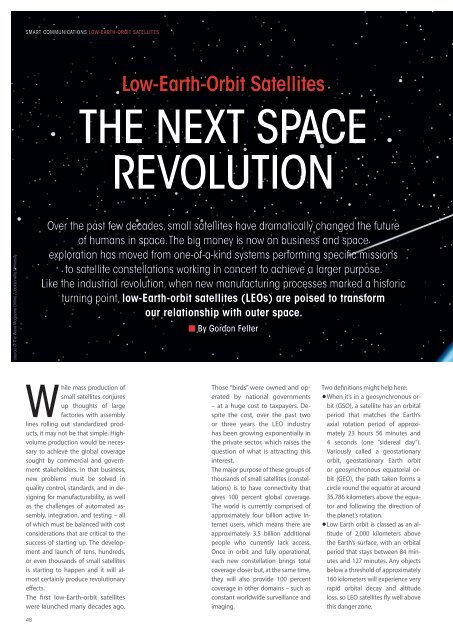Smart Industry 1/2019
Smart Industry 1/2019 - The IoT Business Magazine - powered by Avnet Silica
Smart Industry 1/2019 - The IoT Business Magazine - powered by Avnet Silica
You also want an ePaper? Increase the reach of your titles
YUMPU automatically turns print PDFs into web optimized ePapers that Google loves.
<strong>Smart</strong> Communications Low-earth-orbit satellites<br />
Low-Earth-Orbit Satellites<br />
The Next Space<br />
Revolution<br />
source ©: The Wave Magazine Online / Jacksonville University<br />
Over the past few decades, small satellites have dramatically changed the future<br />
of humans in space. The big money is now on business and space<br />
exploration has moved from one-of-a-kind systems performing specific missions<br />
to satellite constellations working in concert to achieve a larger purpose.<br />
Like the industrial revolution, when new manufacturing processes marked a historic<br />
turning point, low-Earth-orbit satellites (LEOs) are poised to transform<br />
our relationship with outer space.<br />
n By Gordon Feller<br />
While mass production of<br />
small satellites conjures<br />
up thoughts of large<br />
factories with assembly<br />
lines rolling out standardized products,<br />
it may not be that simple. Highvolume<br />
production would be necessary<br />
to achieve the global coverage<br />
sought by commercial and government<br />
stakeholders. In that business,<br />
new problems must be solved in<br />
quality control, standards, and in designing<br />
for manufacturability, as well<br />
as the challenges of automated assembly,<br />
integration, and testing – all<br />
of which must be balanced with cost<br />
considerations that are critical to the<br />
success of starting up. The development<br />
and launch of tens, hundreds,<br />
or even thousands of small satellites<br />
is starting to happen and it will almost<br />
certainly produce revolutionary<br />
effects.<br />
The first low-Earth-orbit satellites<br />
were launched many decades ago.<br />
48<br />
Those “birds” were owned and operated<br />
by national governments<br />
– at a huge cost to taxpayers. Despite<br />
the cost, over the past two<br />
or three years the LEO industry<br />
has been growing exponentially in<br />
the private sector, which raises the<br />
question of what is attracting this<br />
interest.<br />
The major purpose of these groups of<br />
thousands of small satellites (constellations)<br />
is to have connectivity that<br />
gives 100 percent global coverage.<br />
The world is currently comprised of<br />
approximately four billion active Internet<br />
users, which means there are<br />
approximately 3.5 billion additional<br />
people who currently lack access.<br />
Once in orbit and fully operational,<br />
each new constellation brings total<br />
coverage closer but, at the same time,<br />
they will also provide 100 percent<br />
coverage in other domains – such as<br />
constant worldwide surveillance and<br />
imaging.<br />
Two definitions might help here:<br />
• When it’s in a geosynchronous orbit<br />
(GSO), a satellite has an orbital<br />
period that matches the Earth’s<br />
axial rotation period of approximately<br />
23 hours 56 minutes and<br />
4 seconds (one “sidereal day”).<br />
Variously called a geostationary<br />
orbit, geostationary Earth orbit<br />
or geosynchronous equatorial orbit<br />
(GEO), the path taken forms a<br />
circle round the equator at around<br />
35,786 kilometers above the equator<br />
and following the direction of<br />
the planet’s rotation.<br />
• Low Earth orbit is classed as an altitude<br />
of 2,000 kilometers above<br />
the Earth’s surface, with an orbital<br />
period that stays between 84 minutes<br />
and 127 minutes. Any objects<br />
below a threshold of approximately<br />
160 kilometers will experience very<br />
rapid orbital decay and altitude<br />
loss, so LEO satellites fly well above<br />
this danger zone.
















